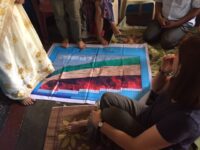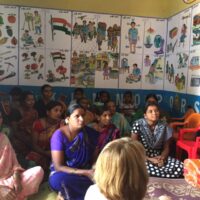
Anganwadi in English means a 'courtyard space' which is exactly how these preschools were formed..in any available space both in the city and in the countryside. The Anganwadi we visited were small spaces, literally on the 'doorstep', but with big visions and aspirations for the children and families.
Mansi at Doorstep Anganwadi in Mumbai had high aspirations for the children there as described in a previous Blog she also said "Parents are very important - they are the main stakeholders in what we do". All the settings talked about this aspiration which sees education as the way out of poverty and also the way to wealth, good jobs, good marriages and a strong future. We have had some very interesting discussions together on the study tour about these aims.
 At Bhugathagalli a rural Anganwadi near Mysore, Leelavathi the Senior Supervisor shared the pre-schools philosophy for the children, the families and the community. The vision being clearly captured in the large painting on one of the walls showing the child at the centre connected to the mother, family and community...reminiscent of Brofenbrenner's theory of development.
At Bhugathagalli a rural Anganwadi near Mysore, Leelavathi the Senior Supervisor shared the pre-schools philosophy for the children, the families and the community. The vision being clearly captured in the large painting on one of the walls showing the child at the centre connected to the mother, family and community...reminiscent of Brofenbrenner's theory of development.
The mission of the centre was to;
- raise awareness and understanding of children's health and physical development through good nutrition and protection against illness and diseases. The government supplied nutritional supplements for pregnant and breast feeding mums and for the children as they got older
- monitor the healthy growth of children (weight and height) using a development chart, very similar to those used by our Health Visitors. There were 3 zones a fire zone (red at the bottom), a sand coloured middle zone and a top zone of lush green grass which is where you hoped the children would be......easy to understand for everyone
monitor the healthy growth of children (weight and height) using a development chart, very similar to those used by our Health Visitors. There were 3 zones a fire zone (red at the bottom), a sand coloured middle zone and a top zone of lush green grass which is where you hoped the children would be......easy to understand for everyone
- support children's early learning including their home language and learning english which involved lots of singing; learning about the land (this was a rural Anganwadi in a small village) and being self-sufficient (one of the teachers had made a wonderful life size working model of a water pump for children to play with); a small pre-school kit supplied to all Anganwadi by the government included a puppet, some stacking blocks and letters of the alphabet. They also had colouring books and crayons
-  promote a funded government programme for mothers to develop their own small businesses from the dairy cattle being farmed in the village. Supporting entrepreneurship and listening to the mothers talking together with us about their children and education in the UK was fascinating - a meeting of minds as we all sat together on the Anganwadi floor
promote a funded government programme for mothers to develop their own small businesses from the dairy cattle being farmed in the village. Supporting entrepreneurship and listening to the mothers talking together with us about their children and education in the UK was fascinating - a meeting of minds as we all sat together on the Anganwadi floor
This is all part of the Balwadi Nutrition Programme (healthcare and education) launched by the Government of India in 1970, to provide food supplements for children of the age group 3–6 years in rural areas.
In brief the Balwadi Programme aims are to make India a 'child friendly' nation where children have a 'happy childhood' and they are
- cherished through freedom and love
- independent self-learners
- learning through their community and nature
- respecting others and learning values
- encouraged to be explorative, innovative and creative
As I sat listening to Leelavathi and Dinesh translating the mother's voices, it reminded me of the vision for our Children Centres, set in the heart of the community, supporting families and children, intervening early both in terms of health and education and the frequent success these centres had in engaging with young mothers, supporting them as well as their children and gradually seeing their confidence and self-esteem blossom.
Sad to think that we have lost many of our Children's Centres and Nursery Schools whilst India is clearly seeing them as the way ahead by bringing care and education together in an Integrated Child Development Scheme.